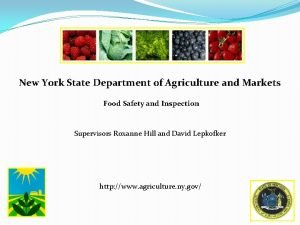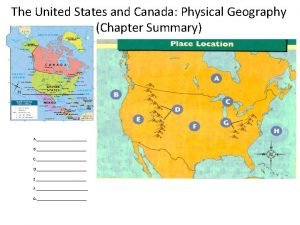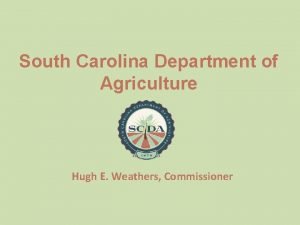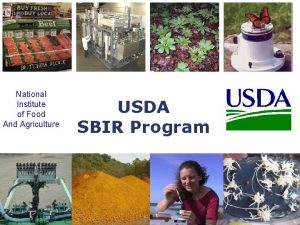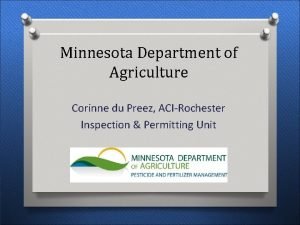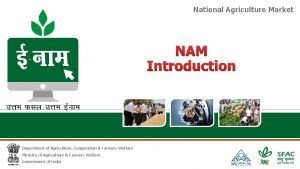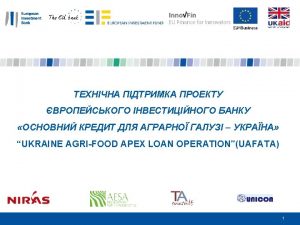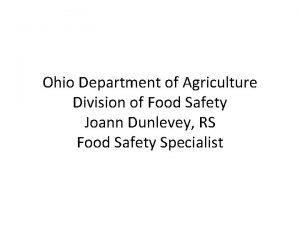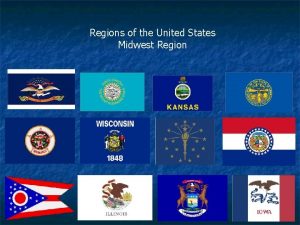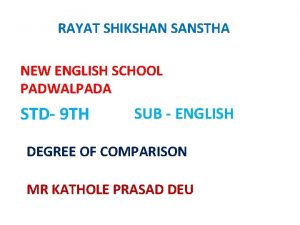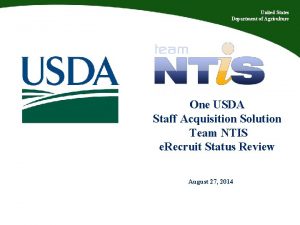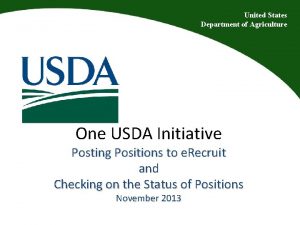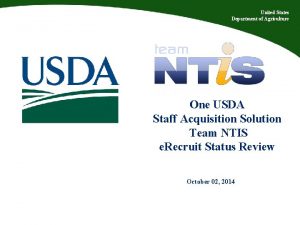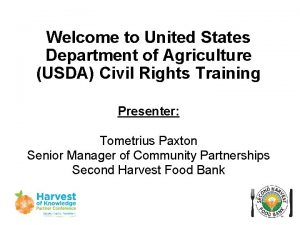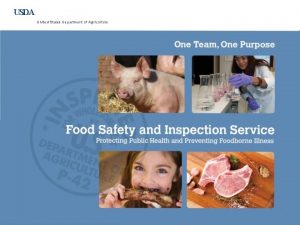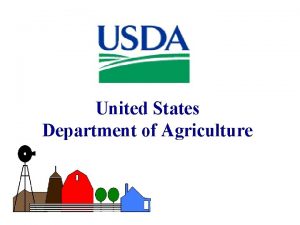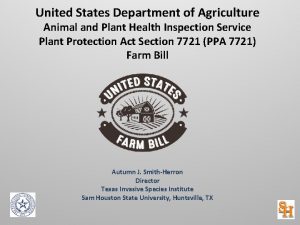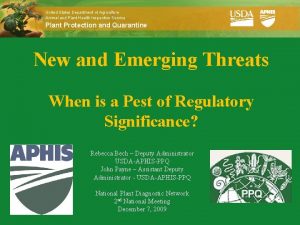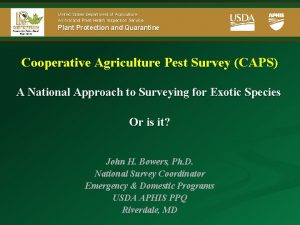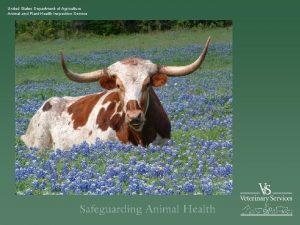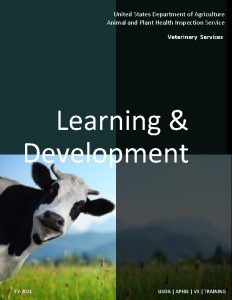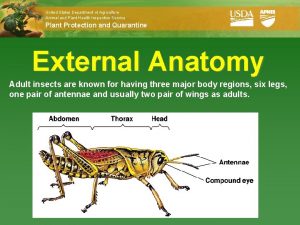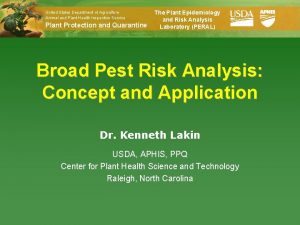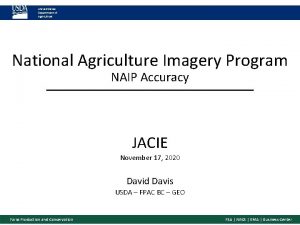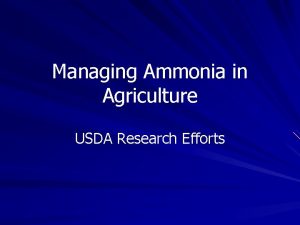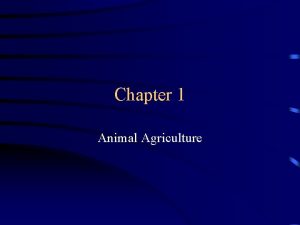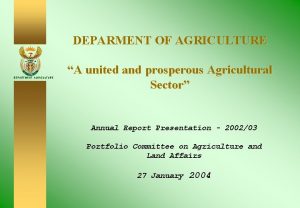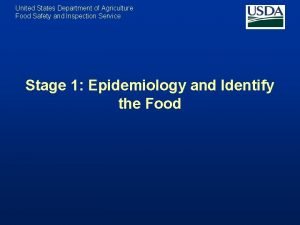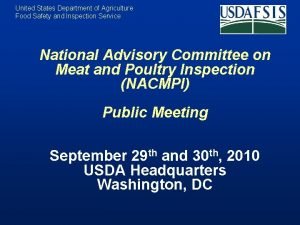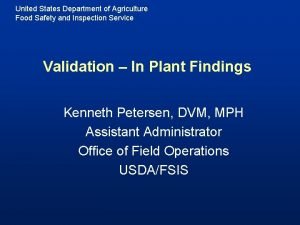United States Department of Agriculture USDA Animal and







































- Slides: 39

United States Department of Agriculture (USDA) Animal and Plant Health Inspection Service (APHIS) Stone Fruit Commodity-Based Surveying

The Story Behind Commodity-Based Surveying What is commodity-based surveying? Why is APHIS moving to this approach? How do producers benefit? Why does early detection matter? What pests are detected by the survey? • How is a survey conducted? • What happens if pests are found? • Why is grower participation critical? • • •

Ultimate goal: Protect value of growers’ crops and stone fruit industry

USDA-APHIS WHAT IS COMMODITY-BASED SURVEYING?

What is Commodity-Based Surveying? • Bundled, comprehensive approach that: – Monitors for many different pests that can infest a single commodity crop – Helps growers better manage risks associated with exotic pest outbreaks – Offers proven, invaluable survey of variety of tree and field crops Team Effort: USDA APHIS, States, and Growers

USDA-APHIS HOW COMMODITY-BASED SURVEY TIES TO COOPERATIVE AGRICULTURAL PEST SURVEY

Cooperative Agricultural Pest Survey • CAPS program pioneered commodity -based approach • Evolution of pest detection and mitigation Single pest survey Area-wide approach Commoditybased method

Cooperative Effort Remains • Program allocates funding to states for implementation of commodity-based survey – Pest-surveillance program – Collaborative effort with industry • Gives states flexibility while prioritizing exotic pests

USDA-APHIS WHY MOVE TO COMMODITYBASED SURVEYING?

Why Is APHIS Moving to This Approach? • Preventive, proven survey method • Safeguards valuable crop investments • Sustains, preserves U. S. stone fruit industry Goal: Protect value of crops, industry

USDA-APHIS HOW DO STONE FRUIT GROWERS BENEFIT FROM COMMODITY-BASED SURVEY?

Benefit to Stone Fruit Producers • Early detection and response • Protection from large-scale crop damage • Support of market access to consumers Goal: Protect value of crops, industry

USDA-APHIS WHY IS EARLY PEST DETECTION IMPORTANT?

Why Is Early Pest Detection Important? Early Detection Can: • Minimize agriculture production costs • • Help reduce major crop losses Enhance product quality and marketability Sustain consumer purchases of commodity Ensure abundant and affordable supply of stone fruit to domestic and export markets Goal: Protect value of crops, industry

How Serious is the Issue? • Globalization increasing risks of exotic pest infestation • Scientist have estimated that invasive species cost the U. S. more than $1 billion annually • Pests bring risk of crop loss, diminished industry value Your participation protects industry, value

USDA-APHIS WHAT PESTS ARE DETECTED UNDER THE STONE FRUIT SURVEY?

What Pests Does the Survey Detect? • Scientists Identified High-Priority Pests: • Summer fruit tortrix • Pear leaf blister moth • Peach, guava fruit fly • European grapevine • European stone fruit yellows moth • Plum pox • Plum fruit moth • European cherry fly • Cherry bark tortrix • False codling moth • Light brown apple moth

Summer Fruit Tortrix • Attacks variety of stone fruits • Damage to foliage is insignificant, but damage to fruit can be serious • Leaves may appear wilted, yellow, shredded, or dead • Feeding on fruits or pods causes scabs or pitting • Not known to be in U. S.

Peach, Guava Fruit Fly Eradicated in California, detected in Florida Attacks variety of stone fruits Adults spotted March to mid-November. Reported to travel at least 15 miles in search of new hosts • Feed on nectar, plant sap, and decaying fruit • Eggs are deposited within the fruit, cause premature fruit drop • Jackson trap is approved trap-andlure method • •

European Stone Fruit Yellows • Epidemic disease • Major threat because of severity of spread and no visible signs • Not known to be in U. S. • Affects tree flowers and shoots in winter • Symptoms – Leaf reddening, rolling – Abnormal yellowing

Plum Fruit Moth • Significant threat because it can develop on many wild and cultivated stone fruits as well as other plants in the same family • Not known to be in U. S. • Appear in April or May, and has one to three generations per year, depending on climate • Larvae chew into fruit, usually near the stem, traveling from the outer part to the pit region and seal up the entrance hole with deposits of chewed fruit skin bound with silk

Cherry Bark Tortrix • Damaging to ornamental cherries, plus Apple and crab apple: almond, apricot, nectarine, peach, and plum • Spread from Washington to Oregon • Active from April to September • Eggs are laid on tree bark either singly or in groups • Wounded trees become more attractive to secondary pests

Light Brown Apple Moth • Recently found in the U. S. • This pest can feed on more than 500 plant species in 121 families and 363 genera • LBAM egg masses are flat, oval, and translucent • Larvae move vigorously when disturbed, but are always connected to the leaf by a silken thread • Majority of economic damage is caused by fruit injury.

Pear Leaf Blister Moth • Leaf miner targets stone fruits • One to five generations per year • Symptoms: – Premature leaf fall – Circular blotches – Dark spiral markings

European Grapevine Moth • Infests grapevine crops, possibly stone fruit • Feeds on developing fruit – Early spring to midsummer B • Present in California • Limited documentation of symptoms – Tunnel throughout fruit – Cocoon around pest’s feeding area

Plum Pox • Worldwide, plum pox virus (PPV) is the most destructive disease affecting stone fruit caused by a virus • Plum pox virus can be transmitted by at least 20 aphid species • In general, the virus is retained on the stylet up to a few hours. Long-distance spread can occur by movement of infected planting materials or grafting • Symptoms can be obvious or very subtle on leaves, fruit, flowers, and seeds

European Cherry Fly • The most significant threat for the United States is its presence in mainland Europe • Females begin laying eggs in mid-June and insert them individually beneath the skin of ripening fruit, then larvae feed on developing fruits for approximately four weeks • Fruit damaged by the larvae of European cherry fruit fly often rots; heavy infestations can reduce marketable yields significantly • Mc. Phail traps are used with torula yeast

False Codling Moth • Attacks variety of stone fruits • Life cycle: – 30– 174 days • Few visual symptoms – Brown spots on fruit – Dark brown waste matter – Yellowish-brown rinds – Premature ripening, fruit drop

USDA-APHIS HOW IS COMMODITY-BASED SURVEYING CONDUCTED?

Survey Process: How It Works • USDA APHIS makes recommendation to states • States use recommendation in deciding pest targets • Surveyors and growers work closely together throughout the process • Surveyors and growers identify trap sites • Surveyors monitor traps and collect data Collaboration: Federal, state, industry, and growers

USDA-APHIS WHAT HAPPENS IF A PEST IS FOUND?

What Happens if a Pest Is Found? • Appropriate response plan launched • Team effort between agencies and growers – Create plan to reduce risk and mitigate pests – Rapid response minimizes large-scale crop damage – Prevents need for more costly, lengthy eradication program Goal: Protect value of crops, industry

Case Study PLUM POX VIRUS

Plum Pox Virus History • First Case in North America: Fall 1999 in Pennsylvania • Hundreds of trees initially infected • Uncontrolled spread may diminish commercial nursery production Threatens stone fruit yields and quality

Rapid Response Plan • Team: Government agencies, growers, and legislators – Quarantined infected crops – At peak, replant ban extended for several hundred square miles – Peaked within four years of introduction Damages exceeded hundreds of thousands of dollars

Plum Pox Virus Mitigation Plan • Field surveys detect infected locations • Only certified, disease-free nursery materials and virus-resistant plants introduced • Control of aphid populations • Removal of host plants, nurseries, and orchards • 10 -year eradication, control effort Result: Pennsylvania free of Plum Pox Virus in 2009

Response Analysis • Without quick response: – PPV may have wiped out Pennsylvania stone fruit industry – Posed significant threat to $1. 4 billion U. S. stone fruit industry • Successful example of government, industry, and growers working together Goal: Protecting value, rebuilding value of Prunus crop

USDA-APHIS COMMODITY-BASED SURVEYS: GROWER PARTICIPATION IS KEY

Growers Critical to Success • Know crop and industry best • Personally invested in crop and operation • Survey will be more effective with grower involvement
 Florida dept of agriculture and consumer services
Florida dept of agriculture and consumer services Virginia department of agriculture food safety
Virginia department of agriculture food safety Maine dept of agriculture
Maine dept of agriculture Nys department of agriculture and markets license
Nys department of agriculture and markets license Awake united states meaning
Awake united states meaning United states and canada physical map
United states and canada physical map Earth latitude and longitude map
Earth latitude and longitude map Unit 2: the united states and canada worksheet answers
Unit 2: the united states and canada worksheet answers Does canada have mountains
Does canada have mountains United states history and government regents
United states history and government regents Unit 2 the united states and canada worksheet answers
Unit 2 the united states and canada worksheet answers The united states emerges as a world power
The united states emerges as a world power Undss security
Undss security Sc department of agriculture
Sc department of agriculture Usda sbir
Usda sbir Altaeros bat
Altaeros bat Doae
Doae Minnesota department of agriculture
Minnesota department of agriculture Department of agriculture
Department of agriculture Department of agriculture
Department of agriculture Ohio cottage food law label
Ohio cottage food law label Was the united states on the axis powers or allied powers?
Was the united states on the axis powers or allied powers? Sectionalism map of the united states
Sectionalism map of the united states Nasl
Nasl Marshall case
Marshall case United states student association
United states student association The united states ought to provide a universal basic income
The united states ought to provide a universal basic income Preamble to the united states constitution
Preamble to the united states constitution The united states in the caribbean 1776 to 1985
The united states in the caribbean 1776 to 1985 Southeast region physical features
Southeast region physical features Expansion of the united states of america 1607 to 1853 map
Expansion of the united states of america 1607 to 1853 map Why did truman believe greece needed aid
Why did truman believe greece needed aid Who was the previous owner of the british cession
Who was the previous owner of the british cession Mapp v ohio
Mapp v ohio We have pacified some thousands of the islanders
We have pacified some thousands of the islanders Guided reading activity lesson 2 roosevelt and taft
Guided reading activity lesson 2 roosevelt and taft Nnn
Nnn 7 regions of the united states
7 regions of the united states The united states is the greatest buyer positive degree
The united states is the greatest buyer positive degree Physical feature map of the united states
Physical feature map of the united states



